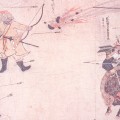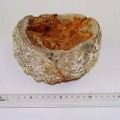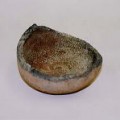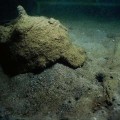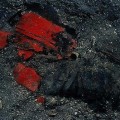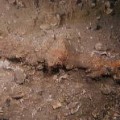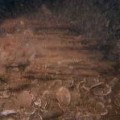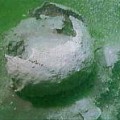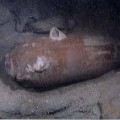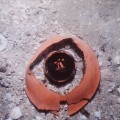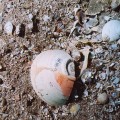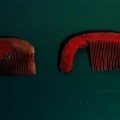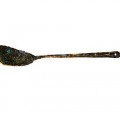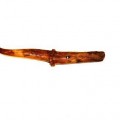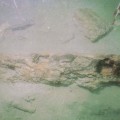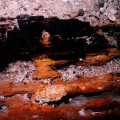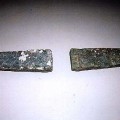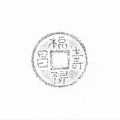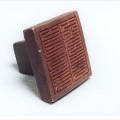Project Takashima
Takashima Underwater Site
The Report of Takashima-cho Cultural Asset Survey
by Takashima-cho Board of Education 1992
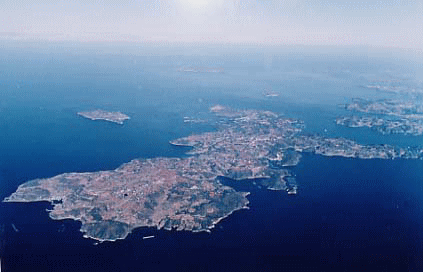
This report deals with the underwater excavation researches carried out at the Tokonami harbor of Takashima Island during 1988 and 1989. The Tokonami site is a depth of 8m at the high tide level. We had to concern that the underwater survey method should be similar to that applied on the land survey;therefore, uncovered artifacts were recorded as precisely as possible at the sea bottom so that we could show the location of every artifact in situ on the map. As a result, some of the artifacts lying in the silt were found in piece separately more than 10m. Not only artifacts belonging to war fleet of the great Mongol emperor Kublai Khan, but also those belonging to the Jomon through Edo period were found in the same stratum. Artifacts of various periods lying in the same context (silt) can prove that stratigraphy were disturbed.
It is 3m thick of the sediment of sand and silt at the excavation area. In 1989, a 3.6x3.6m wooden caisson was experimentally used for excavating the sediment, but this experiment did not get any satisfied result.
The underwater research at the Tokonami harbor was carried out by as follow: 1. establishing the survey area, 2. using air-lifts, 3. recording and measuring uncovered artifacts and remains, and 4. recording with cameras and a video camera. Simultaneously,land works were done by such as 5. maintenance and repair of tools for diving, 6. recovering artifacts which were accidentally sucked up to rafts, 7. filing and numbering artifacts, 8. maintenance and repair of instruments on a pontoon, 9. scheduling working hours at the sea bottom for safety diving, and 10. communicating with a diverphone system between sea bottom and the surface.
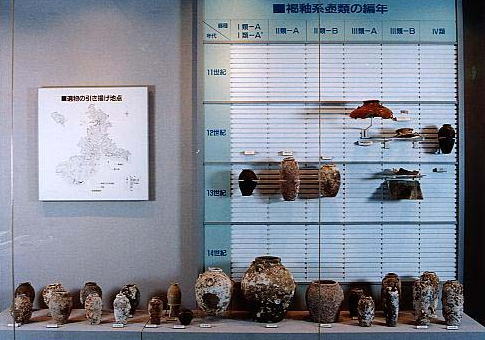
There has been so far a large amount of artifacts found at the southern coast of Takashima Island; however, these all artifacts do not belong to those of the remains of Mongol invasion. Looking into the artifacts relating to Mongol invasion, the number of unearthed Korean artifacts is quite little as comparing with Chinese artifacts. Most of Chinese ceramics of Middle Age unearthed at the Takashima underwater site mainly belong to several types of brown grazed vases, and this tendency is quite different from the diversity of Chinese ceramics as consumer goods unearthed at the other sites of Middle Age. The quality of Chinese ceramics unearthed at the site are not good enough; this implies that those vases were produced in a hurry. It must be an indirect evidence to show an unusual situation of war.
Takashima Underwater Site II
The First Report of Takashima-cho Cultural Asset Survey
by Kyushu and Okinawa Society for Underwater Archaeology
Takashima-cho Board of Education 1993
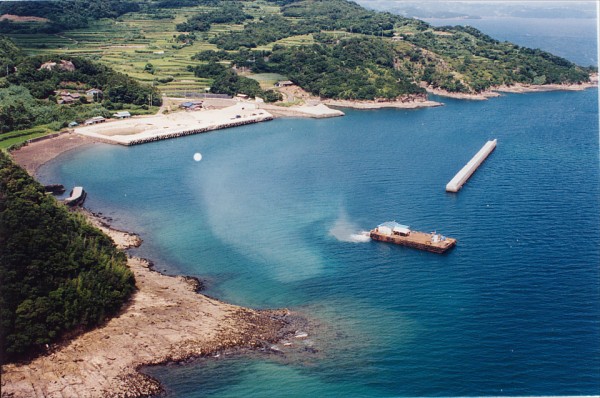
We had expected to find the remains relating to Mongol invasion at an submerged site of the Tokonami harbor. The Early Jomon pottery were found at the bottom of 25m of water instead.
The site was not submerged by the cause of natural disaster like the landslide but was established on the seashore as a land site in the Early Jomon period. Pottery and stone implements without any further damage on their surface can imply that they hardly moved from the original contexts of the land site.
Pieces of silt sampled from the stratum II was examined by the pollen analysis and the analysis of silica body. As a result, plants which are contained in this stratum indicate that the climatic change existed; therefore, there might have been the duration of the time in the stratum II. The analysis of shells also shows the same result. In fact, variation of pottery types indicates to some extent the duration of the time. In other words, there is a possibility that this stratum may be dvided into the contexts of two phases. However, during the excavation there could hardly be any visibility to subdivide the stratum II into two strata at the bottom of 25m of water.
The shells found in the stratum II have been examined by Carbon-14 dating. Two of the results are as follows: 8630±105 yB.P. (8380±105 yB.P.) and 8410±105 yB.P. (8170±105 yB.P.).
It is the first time for the pottery belonging to the Early Jomon period to have been found at the bottom of 25m of water by an archaeological excavation. There are 88 submerged sites having been known so far in Nagasaki prefecture (Fig. 47). Most of these sites have been discovered in the area between the high and low tides; they have lain in a range of -2m through 2m above sea level. They can be seen in Takashima, Iki, Karatsu, and Nagasu; they have concentrated in the western region of Kyushu.
After the last glaciation, the sea level on the continental shelf rose about 9000-8000 B.P. and reached the peak about 6000-5000 B.P. Consequently the submerged sites in Northwest Kyushu, dated to the Early Jomon period, were settled 3m lower than other areas.
Underwater excavation in a deep water of 25m was not yet done before the Tokonami site was surveyed; therefore, existence of many submerged sites in a deep water will be able to be expected in Japan.
Takashima Underwater Site III
The Second Report of Takashima-cho Cultural Asset Survey
by Kyushu and Okinawa Society for Underwater Archaeology
Takashima-cho Board of Education 1996
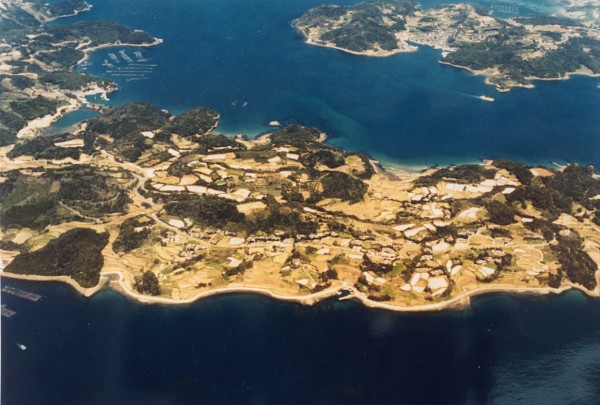
Underwater excavations have been carried out at the Takashima submerged site since 1979.The underwater excavations as rescue archaeology at the site have taken place eleven times. This report deals with the latest two campaigns, which were done during the years of 1994 and 1995. Recording of the underwater surveys was carried out with the aid of members of the Kyushu Okinawa Society for Underwater Archaeology and the continued support of the Nagasaki Prefecture and Takashima-cho Board of Education.
The excavation site is one hundred fifty meters off the cost of the Kozaki harbor and is about twenty one meters deep. Before the excavation of 1994 field season started,four anomalies beneath the seabed at the site had been detected by the aid of sub-bottom profiler. These anomalies were unable to be identified with archaeological remains except for a stone anchor stock. However, this season played a major role in underwater archaeology for history of Takashima Island : three wooden anchors (wooden anchors 2, 3 and 4, which are made of red oak) with a pair of stone anchor stocks respectively in situ in sediment between 1 and 1.5m deep. Wooden anchor 3 is dated to 770±90yB.P. by 14C dating. It is one of the best archaeological documents for which the Mongolian armada invaded Takashima island in 1281.
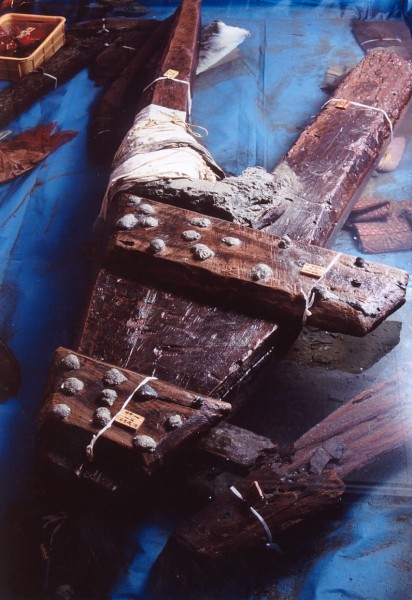
There have been seventy four objects which were unearthed in the 1994 field season (October 14 through December 12) : three wooden anchors, seventeen stone anchor stocks, of which is l30cm long for a large size (two pieces) , 70cm long for a medium size (four pieces) , and 50cm for a small size (eleven pieces) , wooden objects (fifty pieces) , rope like objects (two pieces) , and stone objects (two pieces).
The survey of 1995 field season carried out during July 20 through September 7.During this season, sixty one wooden objects, four of which are iron nailed wooden pieces, one pottery fragment, one bamboo piece, and three animal borns were found.
These archaeological objects discovered in the 1994-1995 campaigns indicate the best documented historic event which took place in Takashima Island, especially discovery of wooden anchors and a set of two anchor stocks will play a major role in the archives for a maritime history in east Asia.
Takashima Underwater Site Ⅳ
1st Report of Cultural Asset Survey at Kozaki Harbo
by Kyushu and Okinawa Society for Underwater Archaeology
Takashima-cho Board of Education 2001
The first test trench excavation of Takashima Underwater Site was carried out at Kozaki Harbor on July 29 through August 7, 2000. The trench is set on the west slope of sea bottom at Kozaki Harbor and is the 2m by10m long. It orients east-west in long axis. The east end of the trench is 12.45m deep and 11.70m for the west end. Its differentiation of the levels between two ends is 0.75m The trench is divided in five 2 by 2m small grids.
The excavation started from the easternmost grid 1-A and moved towards the westernmost grid 1-E. The dredge was used to remove the sediment inside the trench. The top layer of each grid was removed completely under the very low visibility, but the layers below the first layer were finished incomplete except for the grid 1-A.
The grid 1-A consists of four strata: the top stratum is very small fine sand in grayish-brown color, the second stratum is very small fine sand in yellowish-brown color and contains a small amount of small sized shells, the third stratum is sand in grayish-brown color and contains a large amount of relatively larger sized shells, the bottom stratum is gray sand in large pigment and contains large sized shells as well. Two artifacts were found in the bottom layer: one is a shard of Chinese brown-grazed earthenware and the other is a half piece of Chinese brick.
Moreover, twenty-three artifacts relating to the Mongol invasion were collected between the rocks on the slope near the trench: three are brown-grazed earthenwares, and twenty are Chinese bricks.
Takashima Underwater Site V
The Forth Report of Takashima-cho Cultural Asset Survey
by Kyushu and Okinawa Society for Underwater Archaeology
Takashima-cho Board of Education 2001
Chapter I: Procedure of investigation
The southern coast of Takashima Island has been known as the area where the Mongolian fleet had received the devastating damage by the typhoon in l281. In fact, the local fishermen were recovering in nets a lot of artifacts such as jars and vases, and in 1974 a bronze seal engraved with the Paspa characters was found at the seashore as well. The area of about 1,500,000㎡ from the coastline to about 200m offshore was registered as "Nationally Designated Underwater Site" in l982 (Fig. 1), and five rescue excavations have been carried out. During the rescue excavation of l994, the large wooden anchors, which seem to have belonged to the ships of Mongolian fleet, were discovered in situ, and the structure of these anchors came to light.
This time, a bargaining table between the developer and the Takashima-cho Board of Education was held when the offshore breakwater was scheduled to extend, and it reached a conclusion that a prior investigation was necessary. The excavation was carried out from October 16 to November 24, 2000. The developed area is 464 ㎡, and the excavated area is 410㎡. Kenzo Hayashida and members of the Kyushu and Okinawa Society for Underwater Archaeology as well as seven commercial divers carried out the survey.
Chapter II: Survey method and the outline
In the hinterland on the northeast side of the survey area, there is a small valley placed between two edges of the hill, and the valley leads to the sea floor southwest (Fig.2 and 5). The survey area is located in the distance of about 60m-90m from the coastline, and also it is on the gentle slop leading from the wave-cut platform to the flat sea moor The excavation site is -10 through -l4 meters in elevation, and the water is l7 meters maximum depth at the high tide. The layer, which accumulated at the bottom of the sea consists of four layers (Fig.7). I layer: fine gray sand and about 0.2m in thickness. This layer is part of the sand used for the foundation of the offshore breakwater. II layer: olive black colored silt including sand and about 0.3m in thickness. This layer is originally surface. III layer: gray-color sand and about0.2-1.0ml in thickness. The broken pieces of small shells are contained. IV layer: sand mainly composed of the broken pieces of shells and about 0.7-0m in thickness. V layer: shells and gravels.
The air-lift was used for the excavation (Fig.6, Pls.6 and 7). The excavated relics were at first examined by the member staff and then taken pictures of them in situ, and the relics, which were found intensively, were measured and drown by using a frame of the grid of 2×2m. Other relics were recovered after measuring their position and elevation. The visibility in the water was very low because of the humus-decay accumulative layers contained a lot of silts in the bay. The visibility is less than 3 meters at the good condition, but while the air-lift working its visibility lowered by several centimeters.
Chapter III: Discovered artifacts
The artifacts of the Modern times were found from the first through third layer, and the artifacts related to the Mongolian forces were found from the fourth through fifth layer. However, these discovered artifacts were not associated with the hulls. The total of the excavated artifacts is l95, but several pottery shards belong to the same artifact. Therefore, a final account of the excavated artifacts reaches l68; seventy-four ceramics, sixty-one metal objects, fourteen wooden artifacts with metal objects adhered, fifteen wooden artifacts, one brick, one obsidian, one natural tree, and one unknown artifact have been excavated. A lot of artifacts have been found in the shallow water of the northeast area of the site. The ceramics and pottery have been broken pieces, but many pieces are relatively large fragments. Moreover, the fragments of eight groups out of thirteen groups have been found along the axis of roughly southwest to northeast. These have been almost connected to the isobathic line at the right angle (Fig.8).
Forty-four ceramics among seventy-four earthenwares and ceramics have been shown; two Hizen porcelains1 (Fig. l3: 1 and 2), one Koryo celadon (Fig.13: 3) and rest of them, forty-one are Chinese ceramics. These Chinese ceramics consist of seven bowls such as white porcelain (Fig.l3: 6- 8), blue celadon (Fig.13: 3 -5), black grazed ware (Fig. l3.9), and thirty-four are brown grazed vases. Twenty-four among these vases have a long body and four lug-handles and are the largest group in quantity (Figs.14 and 15:13-36). The similar type has been found at the Sinan shipwreck site, South Korea and the Hakata sites, Fukuoka City. Bowls of many types and standardized types of vases are characteristic pottery, which have been found at Takashima. In other words, it can be said that an assemblage of bowls, which personally belonged, and eleven vases, which stored war supply, can reflect the aspect of the ceramics that the Mongolian force (the South Route Force) carried. In addition, it seems as suggestion of the difference of the damage met at Takashima that the number of the Koryo ceramics is far less compared with that of the Chinese ceramics, and this is corresponding also to the chronicles written in the Middle Ages.
Moreover, there are unglazed bricks as one of the distinctive artifacts having been found at the Takashima underwater site (Fig.16: 45). It is not excavated voluminously in the country though they are seen uncommonly in the Hakata sites. As for them, there are neither an amount nor a standard of the idea as use as ballast of the ship and materials for buildings, and the possibility to be used as part of the kitchen oven is high. As to the variety of the classification, it should consider a regional diversity by the different regions where the unglazed bricks were made (Figs.17 and l8, Tab.8). In other words, they can represent the regional differences of the ships with the kitchen ovens installed (Pls.20 and 2l).
Two large wooden artifacts nearly 2 m in length have been excavated though all wooden artifacts had been infested by the shipworms: one of them has a curved projection with a square hole pierced from the side (Fig.20: 47). This feature is similar to one belonging to the dugout canoe which has been found in the Anapci pond of South Korea (Fig.22). Another wooden board, which seems to be belonging to part of a bulkhead (Fig.20: 49), has been found in the same pond.
As for bronze artifacts, seven brass made-fittings of the belt and one bronze mirror have been recovered (Fig.23, Pls.25-27). Iron artifacts have been corroded and the state of condition is not good and swollen (Fig.24). Moreover, one relic which seems to be a bundle of the arrows has been excavated, and X-ray photo was used to examine the inside of the arrows, but the state of condition as well as other iron artifacts is not good, and the original shape does not remain. A shaft of the arrow is about 8mm in diameter. The arrows seem to be kept in the bundled state or in the quiver (Pls.28 and 29).
Chapter IV: Scientific analysis of artifacts
14C dating of large woods was measured by using No.2 tandem accelerator mass spectrometer with cooperation of the Nagoya University Center for Chronological Research (Fig.25). Sample (no. l5) dates 838±20 yB.P., and sample (no.18) dates 864± l8 yB.P. Moreover, the artifacts found in 1994, such as the bamboo rope of no.3 anchor and the shaft of the anchor (no.24) are dated 747±l9 yB.P. and 77l±19 yB.P. respectively.
Seven samples of wood for identification of pieces of trees was examined with the cooperation of Takumi Mitsutani (Nara National Cultural Asset Laboratory), and they turned out that all were the Cinnamomum camphorsa Presl (Pl.30). They naturally grows in the central and southern regions of the Mainland, Shikoku, and Kyushu, furthermore, they are distributed in South Korea (Jeju Island), Taiwan, the central through southern region of China, and Vietnam. Many examples having been used as the dugout canoe are confirmed from ancient times, and they have been used as timbers for Chinese plunk-built ships.
The fluorescent X-ray analyses for bronze objects have been done by the cooperation of Yoichiro Hisa and Masaki Katata (Fukuoka City Archaeological Center); a bronze mirror (Song dynasty) contains very small amount of Fe, Ni, Zn, As, Bi, Ag, and Sb as an element and is most likely aroid by tin (Figs.26 and 27). Metal fittings of the belt are thought to be brass because of containing zinc and copper to be a main ingredient (Figs.29 and 30).
Chapter V: Result of survey and some issues in the future
During the l994 season, it became possible to presume the sea floor of the time of the Mongolian invasion in the silt layer accumulated one meter beneath the bottom, and for this time, it became to be one of the major issues to verify intact condition of artifacts in the sandy layer mainly accumulated along the seashore. Most artifacts have been found in the Ⅳ layer composing mainly the pieces of shells or in the upper section of the V layer.
The pieces of shells in the sandy layers become gradually larger when comes to deeper sediment, and the V layer is a layer which contained gravels and originally shaped-shells. Therefore, the Ⅲ layer through the V layer received the influence of the wave under bottom of the sea by the change in non-daily oceanographic condition and shows the situation which accumulated again. In other words, it seems that the artifacts piled up again as the shell and gravel did so. The movement of the artifacts by the action of the wave was elucidated from connecting broken pieces together.
As for the accumulating process of artifacts, the relic was able to be elucidated according to the distribution density of the artifacts. Moreover, each section of connected relics is the reasons why shellfishes adhere, and the change in non-daily oceanographic condition is high the possibility of there is several-time. Shellfishes' adhering ages and mixing the relic after the Mongolian invasion will become keys to elucidate the formation process of the Takashima underwater site in the future. In addition, it is the one to suggest the possibility of keeping the state when the hull sinks in the point which has depth in which the influence of the wave is not received easily.
The brown-glazed vase with four lug handles, which occupy more than a half the number of the recovered ceramics and pottery, are produced in a large scale at a time, and the region where they were produced is assigned to Yixing, Jiangsu province of China (pp.60-63)1) Yixing is located near Qingyuan, from which the Southern Rout meet started to sail for Japan. A large amount of these vases might be on board as container of storage vessels, moreover, the granite anchor stock of the wooden anchor found in 1994 assumed that there is a possibility that granite found around Guangzhou, Fujian province (pp.64-69)2). As for the bowls of crude celadon and white porcelain which seem to have been produced in the southern provinces of China, circulation as the trade ceramics seems to be small, and these bowls are most likely the personal belongings of the southern route army.
The provinces where these bowls were fired seem to be correspondent with the places where the ships were requisited in some degree. Therefore, it is necessary for the ceramics to take account of the circulation in China.
In addition, the ship materials, which three is a possibility that a technical genealogy belongs to the Korean peninsula, have been found. It seems that it will be possible to contribute the research of the ceramics including Chinese ceramics according to the situation in which the artifacts are excavated in the future though the Koryo ceramic bowls assumed to be dated late in the present study. Moreover, it is thought to have been able to offer historical specimens to the elucidation of Asian history what the arrows and bronze fittings of the belt have been found.
1) Based on the research of Tatsuya Mori.
2) Based on the research of Kazuhiro Suzuki, Yoshifumi Karakida, and Yasuhiko Kamada.
Takashima Underwater Site VI
2nd Report of Cultural Asset Survey at Kozaki Harbor
by Kyushu and Okinawa Society for Underwater Archaeology
Takashima-cho Board of Education 2002
The underwater excavation of the Kozaki harbor was a schedule for ten days and trial excavation of the survey area of 2 m X 10 m. Because of short term and small area, it is difficult to look for many results. Eight artifacts have been found at the top of the 3rd stratum. One of them does not belong to the related object of the Mongolian fleet. The other objects such as one shard of blue celadon bowl, four shards, one nearly undamaged earthenware, and a bundle of arrows have been found. Though there is an example discovered by the rescue excavation of last year, during the campaign the arrows have been excavated under the condition that over seventy arrows came to be a rusted and harden bundle. Though X-rays photography has been used to see the inside condition, but it cannot be recognized clearly. It is proved that iron almost disappeared.
The archaeological campaign which carried out last year helps to understand the strata of the sediment of the Kozaki harbor. To understanding the accumulation of the sediment, it will be useful and an important data for the archaeological excavations which will be carried out in future at Kozaki. An important and key stratum of the accumulation at the Kozaki harbor could be grasped. The strata, which they should pay attention to in the accumulation strata, are the third stratum. This stratum includes relics related to-the Mongol invasion. The characteristic of this stratum is to contain the big sized shells in large quantities in the gray coarse sand stratum. This stratum is a comparatively hard sand stratum, and it confirms that relics related to the Mongol invasion are found on the upper part of this sand stratum.
Takashima Underwater Site VII
The Sixth Report of Takashima-cho Cultural Asset Survey
By Kyushu and Okinawa Society for Underwater Archaeology
Takashima-cho Board of Education 2002
Chronicle says that 4400 ships of Mongolian were heavily damaged by a typhoon hit Kyushu in l28l and that most of them sank off the coast of Takashima Island. The Ministry of Culture and Science designated the Takashima underwater site as a nationally designated place for buried cultural property in 1981. Since then, seven rescue excavations and twelve excavations of institutions have been carried out. This is a prerimary report of the latest rescuer excavation, which was taken place at the Kozaki harbor, Takashima Island from August l7th though October 25th, 2001. A large number of Chinese pottery and ceramics have been found alongside with plunks and mast step, arms as arrows, swords,and pottery-made round shells. The rescue excavation of the Kozaki harbor will resume in summer of 2002.
Takashima Underwater Site VIII
The Seventh Report of Takashima-cho Cultural Asset Survey
by Kyushu and Okinawa Society for Underwater Archaeology
Takashima-cho Board of Education 2003
This is an interim report of the rescue excavation carried out the Kozaki harbor of the Takashima underwater site. the survey was conducted on July 11 through December 7, 2002, and the excavated area is 950 square meters. As for the result of the survey, firstly, the variety of the unearthed artifacts including the character materials can be seen, the ship material such as hull planks, part of a watertight bulkhead, and a mast step have been uncovered. Though the hull has not been discovered, they are the important materials for the restoration of the ship of Kublai Khan's fleet according the comparison with the samples discovered in other countries.
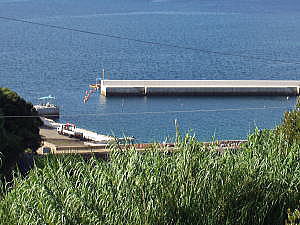
There are over three hundred shards of Chinese ceramics, and ,most of them are large pieces and can be restored in a full scale. Most Chinese ceramics are the brown-glazed jars with four lug handles fired in the Yixing kilns, Jiangsu Province, China. they seem to be used for container to carry necessities from Ningbo, but there has been no evidence to be able to confirm contents. As to the Chinese earthenwares, there are few samples found at the archaeological sites of Japan; therefore, their type will be able to become a standard to establish chronology.
As the serving dishes, they can be divided into major products in quality: relatively well-made bowls fired in the Jun kilns, Henan Province and celadon bowls and plates fired in the Longquan kilns, Zhejiang Province, and celadon bowls and plates in poor-quality fired in most likely Fujian Province, which were not imported as many as commodities into Japan. This seems to indicate the difference in the use of serving dishes among the classes of the fleet's member. If the kilns are identified and the distributed areas in China are studied, it will become a clue to identify the places of requisition or the harbors of departure.
There are arms such as helmets, swords, arrows, small armor plates, and the earthen-shelled bombs "tetsuhau" that show the existence of the army, and other objects like lacquer bowls, combs, bronze pot, bronze spoons, and bronze coins as the goods of daily life have been uncovered as well.
The Takashima underwater site is a trace of the Mongol invasion as the non-daily incident, and the uncovered arms indicate the situation under the wartime. However, other daily goods indicate to be rather close to the daily life of the second half of the 13th century in China, and this site has an unique character as an archaeological site of Japan. These finds and the examination of the uncovered character materials can help various themes emerge in the disciplines of not only archaeology, but also the Asian history, the history of art, the history of shipbuilding technology, and the military history. When you will take account of the evaluation of the relics and the method of the survey in the future, it is a fruitful result to have been able to confirm not only abundant relics, but also the sedimentary environments. Due to the effect of extraordinary wave movement, the sand layer, which piles up along the shore has been disturbed; therefore, the relics from the Jomon period to the early modern age have been found above the lower level of the sandy silt layer one meter deep from the seabed off the shore has been confirmed, but it will be a further issue to examine whether or not, it indicates the state of condition of the seabed immediately after the Mongol invasion. If it is confirmed, it can be judged as the same period to which unearthed objects belong.
If you confirm and study that several shards of the ceramics unearthed apart in the sand layer and the sandy silt layer have relations to be connected each other and the stratigraphy of the wooden objects has distribution pattern. It seems to be reconstructed the formation process of the Takashima underwater site. However, it does not mean to limit only the reconstruction of the formation process. More than hundred objects have been found on the slop along the shore.
If the distribution of objects will be chosen, and trial excavations will be carried out under the similar circumstance to this excavated area, it is possible that a sunken vessel itself will be discovered in the future.
Takashima Underwater Site IX
3rd Report of Cultural Asset Survey at Kozaki Harbor
by Kyushu and Okinawa Society for Underwater Archaeology
Takashima-cho Board of Education 2003
The underwater archaeology at the Kozaki harbor was carried out by KOSUWA on Dec.9 through Dec.20, 2002, and the survey area is sixteen square meters(4 X 4 m). As the result of the excavation, twenty artifacts relating the fleet of Kublai Khan have been found intact. These artifacts have briefly been described as follows.
Bronze Coins (PL.50)
Eighty-eight pieces (No. l) have been found in situ in the grid of l B. They have “Tai ping tong bao” in Chinese characters on obverse. They were firstly minted in 976 of the Northern Song.
Ion Nails (PLs.26, 39,40)
They have been found intact; a rusted flat nail (No.2) yielded in I B; a cluster of eleven nails (No. 11) found in 1 A, and a sickle-like object (No. 8) consisting of blade and socket found in 2 A. The last iron object would have been used as farming instrument after the army of Kublai Khan occupied and settled in the land of Japan.
Brick (PL. 50)
No.l9 found in I A has been partly survived; it is 8.55cm long, 7.0cm wide, and 5.4cm thick.
Wooden Artifacts (PLs.27,28,32,33,35,41,42,47)
A staff-like object (No.3) found in 2 B consists of two half-round pieces of wood, and they are bound together by a polished wooden ring at either end. One end in large diameter is broken off from the rest, and the other end is survived. A narrow hole on the surface is engraved by 4.4cm long, 0.4cm wide, and 1.5cm deep. Part of wall or door (No.7) has been found in 2 B. This object is not seen any nail on the surface, instead glue was used for binding. The surface of either end is burned. This object however may have been found in a disturbed layer because of new construction of a breakwater. This timber (No.9) has been found in 2 A, and no nail has been found on the surface. The remains of two branches are survived. This small piece of wood (No.12) has been found in 1 A. Two grooves for the nails are seen in parallel. This timber (No.13) found in 1 A was cut in half vertically. No.17-1 found in I A is a small piece of board. Two grooves for the nails run parallel. No.l7-2 has been found in 1 A. It seems to have been burnt.
Sheaths (PLs.6,43,44,48,49)
A wooden case for a knife (No.6) found in 2 B was lacquered in black. Survived length is l8.5cm, 2.58cm wide, and 0.64cm thick. A bamboo-made sheath (No.14) found in I A was lacquered in black. It is 27.3cm long, 5.69cm wide, and 2.95cm thick. A bamboo-made sheath (No.l8) found in l A was lacquered in black. It is l4.2cm long, 5.79-5.97 cm wide, and 1.98cm thick.
Ropes (PLs.29 and 45)
No.4 and No.l5 have found in 2 B and 1 A simultaneously. They are made of hemp-palm and coiled counterclockwise. No.4 is 5.0-5.5mm in diameter, and No.15 is 13cm in diameter.
Lacquer Wares (PLs.30, 36-38)
No.5 is a shard of bowl. Interior is lacquered in red, and black for exterior. No.10 is a bowl, and base is missing. Interior is lacquered in red except for bottom lacquered in black with petal design, and mouth is lacquered in black 2 cm wide. The mouth of exterior is lacquered in pure black 1.4cm wide and other area is also lacquered in black. Mouth is 19.5cm in diameter and 7.0cm high.
Bone (PL.46)
No.16 is a small piece of bone. It is 11.8cm long, and joint is 1.4cm wide,0.7cm thick, and 4.65g weights.
Takashima Underwater Site X
4th Report of Cultural Asset Survey at Kozaki Harbor
by Kyushu and Okinawa Society for Underwater Archaeology
Takashima-cho Board of Education 2004
The survey was taken place for a small-scale excavation to understand in detail the vessels of Mongol fleet and their cargo at the Kozaki harbor on July 19 through August 6, 2003. The excavation was carried out at seven small grids west of the area where was excavated last year; these grids are situated in the grid 8AA surrounded by W50-60 and N30-40, which is just west of the grid 8A where the Mongolian-Invasion related artifacts were found in large quantities by the rescue excavations of 2001 and 2002 seasons, and the excavated grids of the 2003 season were enclosed by W51-W56.5 and N37-N40, and 15.5 square meters were excavated.
Forty-eight artifacts have been found in six grids of the excavated area: four timbers in the grid 1A, six timbers, two metal objects, a piece of bone, one brick, and a piece of Chinese ware in the grid 1B, one timber, one brick, and a piece of cloth in the grid 2B, twenty-six artifacts unearthed in the grid 1C: twenty timbers, a piece of bone, one brick, two metal objects, and two pieces of Chinese wares, two pieces of ropes and one timber in the grid 2C, two timbers in the grid 1D.
Among thirty-two timbers unearthed at the excavated area, only three specimens are longer than 1.5m, and the marks of carving can be seen on two specimens out of three. No. 8 timber is most likely to belong to part of a vessel; this timber has a rectangular -shaped niche like "凹" measuring 25cm wide and 8-8.5cm deep, and No. 50 iron object in the shape of a very thin and narrow sheet with four small nail holes was found north closely to the niche. Moreover, two specimens out of all timbers unearthed, such as No.16 and No.17 timbers have been survived by a small portion of the original size with a diagonal-cut end. they seem to be parts of the planks of a small vessel, and they have been connected together by iron nails. the iron nails, however, were completely lost away, and the nail holes were left in the timbers.
It is the first time to have such the specimens of the timbers that have been unearthed at the Takashima underwater site, and we have understood how two diagonal-cut ends of the planks can firmly be connected.

